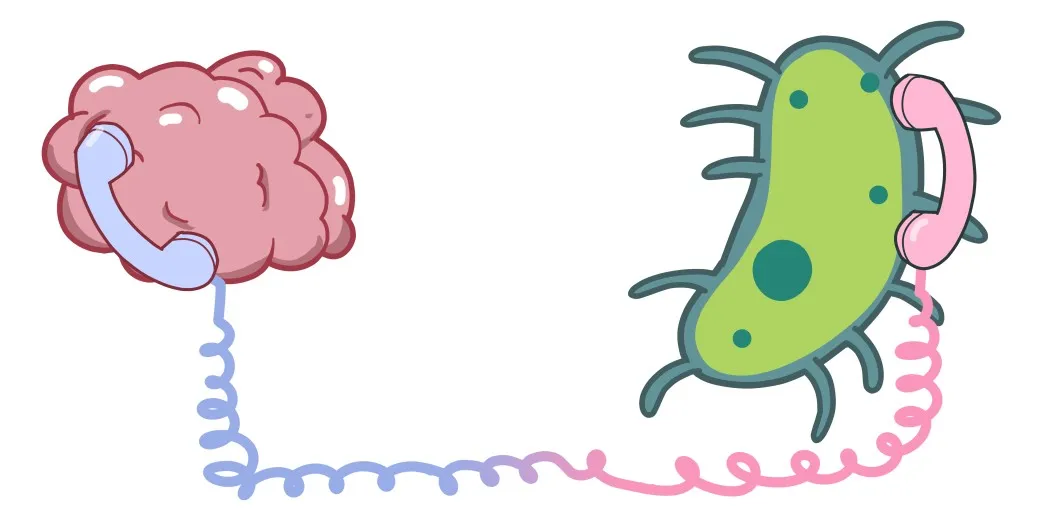What is the Gut-Brain Axis & how does CBD affect it?
Don’t feel like reading? Listen instead! (10 min read)
Did you know you have a 2nd brain?
That’s right! Your gut is often referred to as your “second brain” because it actually has its own nervous system. The Enteric Nervous System governs the function of your gastrointestinal tract. It controls actions such as motor function, secretions, and localized blood flow while modulating immmune and endocrine functions.
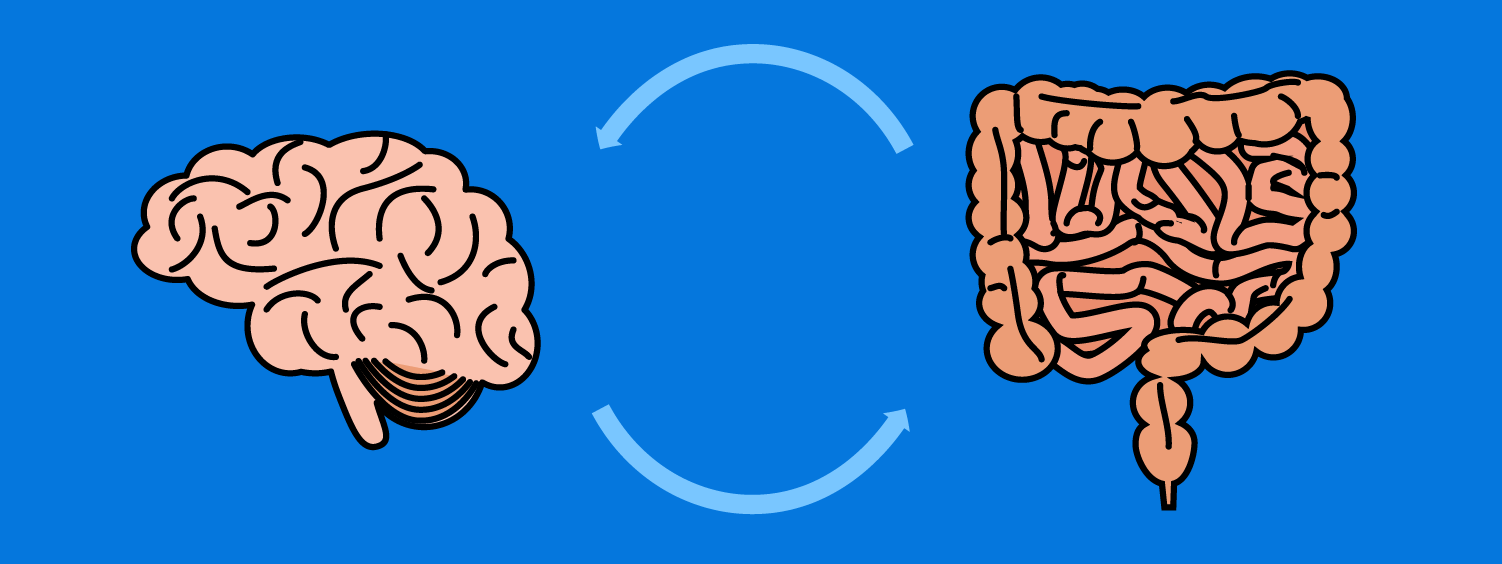
When it comes to fully understanding the control centers that dictate our mental and physical experience, the Enteric Nervous System is one part of a larger picture: The Gut-Brain Axis.
What is the Gut-Brain Axis?
The gut-brain axis is a bidirectional communication pathway between our two brains – the one in our gut and the one in our head – linking emotional and cognitive centers of the brain with peripheral intestinal functions. While the Vagus Nerve has always been the focal point of the system – connecting the two regions and carrying the messages between them – recent research has pointed to the important role gut microbiota plays in the gut-brain axis as well.
Believe me, we will get back to the vagus nerve and how the axis actually works. But, first let’s talk about the importance of gut health, nervous system activity, and the endocannabinoid system. Here are the key points to understand:
- Ease or dis-ease is mostly a downstream function of gut health and nervous system activity.
- The gut and the nervous system are two areas that set the tone for how the whole body is feeling.
- Most of our Endocannabinoid System’s receptor sites are concentrated in the gut and nervous system.
- The role of the Endocannabinoid System is to modulate the functions of disparate physiological systems in order to restore and maintain homeostasis: our bodies’ ideal state of balance
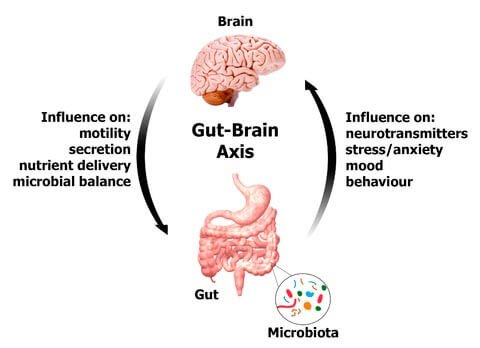
Fun facts:
- 70% of our bodies’ immune cells are located in the gut.
- Key chemical messengers such as serotonin and GABA are largely produced in the gut.
If action along the gut-brain axis largely dictates what’s happening in the rest of the body, then it makes sense that the ‘Master Regulator’ (the ECS) should be right there in the action.
Our ECS has the ability to up-or-down regulate certain actions, such as immune function or neurotransmitter activity, as needed in the interest of restoring and maintaining homeostasis. What’s the enemy of homeostasis? Stress! So, let’s get into the major role that the gut-brain axis, and ultimately the ECS, plays in our stress response.
The Vagus Nerve & Autonomic Tone
The vagus nerve is what actually connects our brain to our GI tract, sending bidirectional messages between the 2 systems and serving as a true bridge between body and mind. If you’ve ever experienced butterflies in your stomach or had a “gut feeling” about something, then you’ve experienced your vagus nerve at work.
What happens in vagus does not stay in vagus. The messages relayed via the vagus nerve actually affect our entire physiology and overall autonomic tone.
Our autonomic nervous system (ANS) plays a major role in our stress response. The ANS consists of our sympathetic (fight or flight) system and parasympathetic (rest and digest) system. Autonomic tone refers to the balance between sympathetic and parasympathetic nervous system activity.
Chemical messengers set the tone
The vagus nerve elicits the output of several important neurotransmitters produced in the gut – namely serotonin, GABA, norepinephrine, and acetylcholine. Evidence suggests that one of the ways in which the vagus nerve facilitates communication between the brain and gut is by moving these neurotransmitters between the two systems.
These chemical messengers modulate our stress response, mood, sleep, appetite, heart rate, sex drive, memory, and pain perception. By modulating our stress response, these neurotransmitters actually control our autonomic tone.
Did I lose you? Just in case, let’s break it down:
- The vagus nerve and gut-brain axis are key components of our autonomic nervous system.
- Our autonomic nervous system is divided into sympathetic and parasympathetic nervous systems.
- The sympathetic nervous system = fight or flight; initiation of our stress response.
- Fight or flight is triggered by the release of norepinephrine (excitatory neurotransmitter).
- The parasympathetic nervous system = rest and digest; termination of our stress response.
- Rest and digest is triggered by the release of GABA (inhibitory neurotransmitter).
- Autonomic tone is the balance between sympathetic and parasympathetic activity
- Sympathetic and parasympathetic activity is a result of excitatory and inhibitory neurotransmitter activity, respectively.
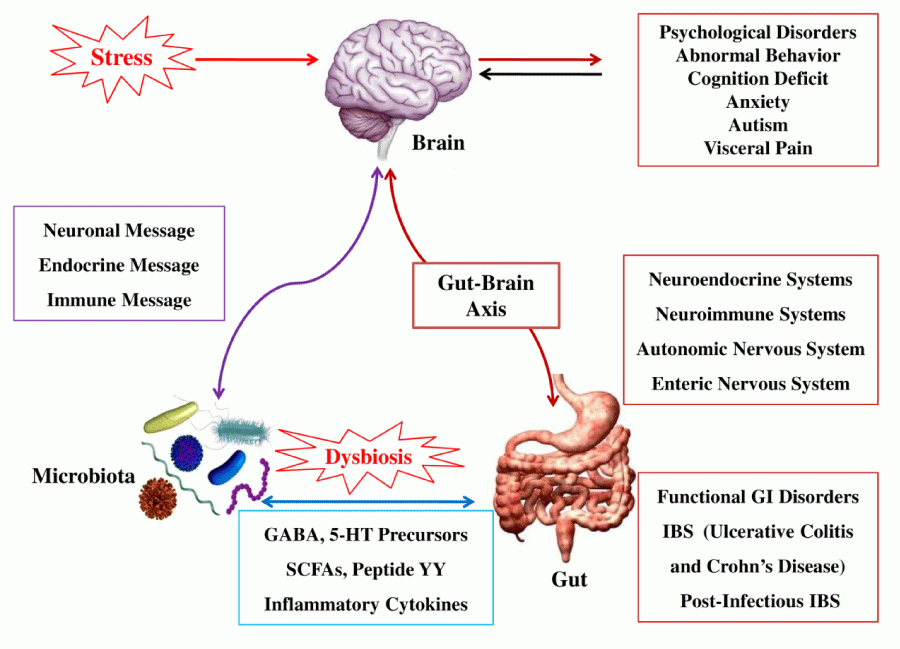
The Gut-Brain Axis & Our Stress Response
The initial stress response is mediated by the vagus nerve and the release of norepinephrine, which activates the sympathetic nervous system. In other words, the vagus nerve is responsible for flipping the switch between ‘rest and digest’ and ‘fight or flight’.
That autonomic action triggers the next phase of our stress response, which occurs along the hypothalamic-pituitary-adrenal (HPA) axis. Some moments after fight or flight is activated, the HPA axis floods the body with stress hormones (cortisol), signaling a cascade of downstream physiological changes designed to improve our chances of survival.
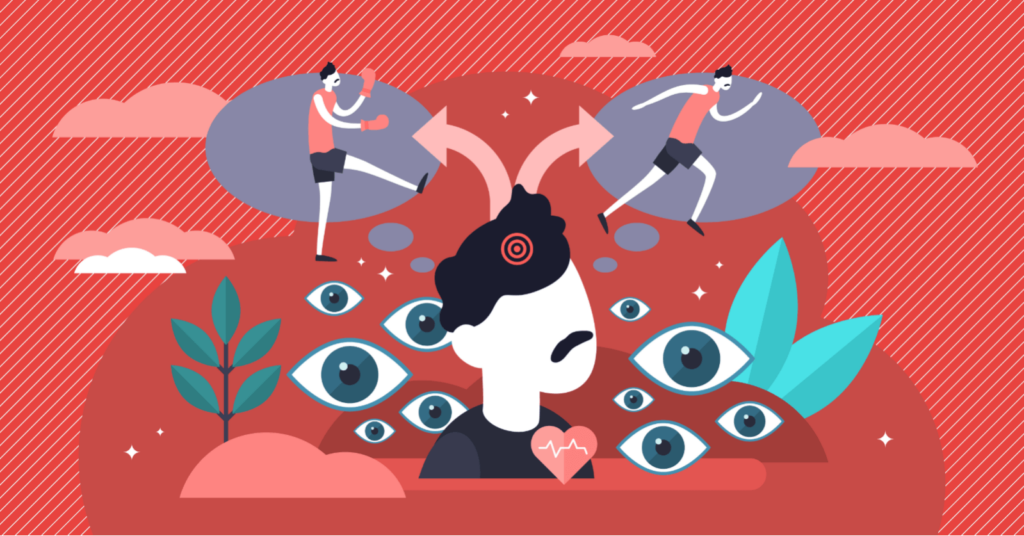
During survival mode all non-essential functions, including digestion and higher level cognitive thought, are put on the back burner. Norepinephrine, cortisol, and adrenaline are telling your body “GO, GO, GO!”.
Once the threat has subsided and we are safe, the parasympathetic system takes over and returns us to our regularly scheduled programming.
The vagus nerve is a major conduit of the prasympathetic nervous system. So, while it can signal fight or flight, where it really shines is in its ability to flip the switch back to rest and digest. This process is characterized by the release of GABA, which signals nervous system activity to slow down – the threat is over and it’s time to recover.
If norepinephrine is your body’s accelerator, GABA is the brake pedal.
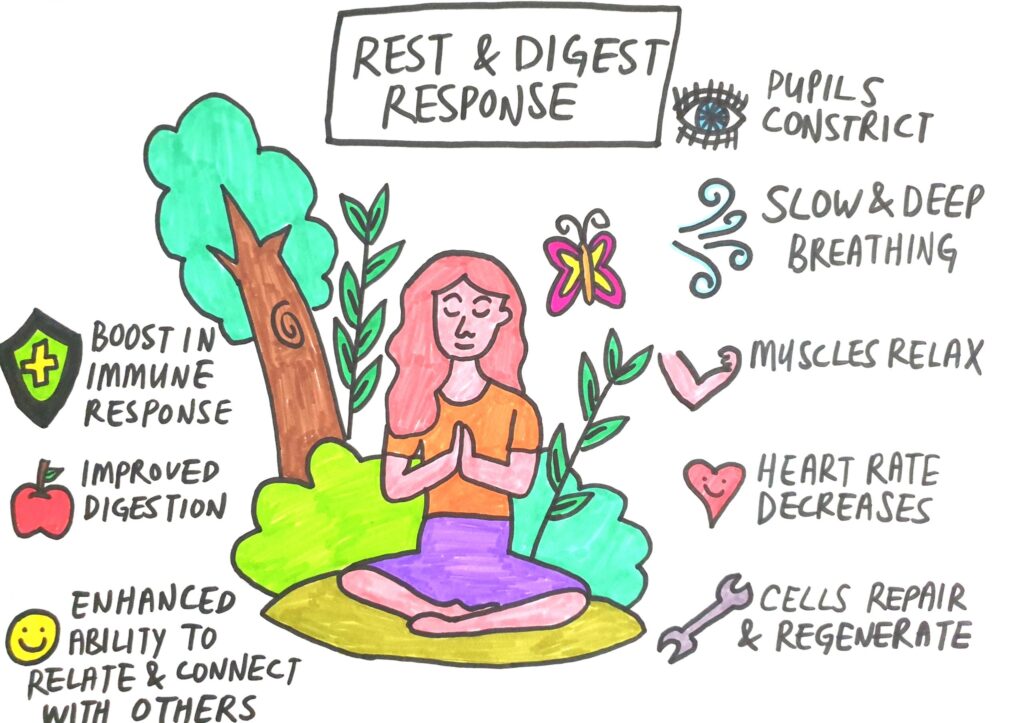
Another fun fact: one of the ways in which your vagus nerve can determine when the threat has subsided and that it’s time to get that GABA going is through the movement of your diaphragm!
- The movement of your diaphragm during deep breathing actually tugs on your vagus nerve. That tug tells the vagus nerve that you’ve made the transition from quick, shallow breaths, to slow deep breaths. It takes that information as the go ahead to transition from fight or flight to rest and digest – you’ve outrun the bear, you’re in a safe spot and now it’s time to recover.
The effects of chronic stress
The quick activation and recovery cycle described above is the ideal scenario. An acute threat triggers the stress response. You outrun that threat, you are safe, and your body recovers and transitions to rest and digest. That is tip-top autonomic tone on display!
Unfortunately, stress has become less clearcut and finite in modern life. We are not running from a bear, we are dealing with mild unpredictable stressors all day everyday. This kind of long term, chronic stress can result in over-activation of the HPA axis, chronically elevated cortisol levels, and something called sympathetic overdrive.

Under the conditions of chronic stress, it becomes more difficult for the parasympathetic system to take over because the amount of stress hormones is so high that the usual amount of GABA can’t compete. So, unable to effectively transition from fight or flight (sympathetic) to rest and digest (parasympathetic), you become caught in sympathetic overdrive. In this state, you are likely experiencing anxiety, fatigue, trouble sleeping, weight gain, GI issues, brain fog, irritability, and widespread inflammation.
Gut Health = Mental Health (and vice versa)
Remember that the gut-brain axis consists of bidirectional communication. This means that mental health issues can lead to GI issues, and GI issues can lead to mental health issues.
Neurotransmitters like serotonin and GABA are largely formed in the gut. If your gut is not a balanced, thriving environment you’re not going to be producing those feel-good chemicals at the same rate. Communication along the axis is going to get muddied up and a rift begins to form between mind and body.
Gut bacteria, or your microbiome, is a super important element to consider. Having the right balance of bacteria is what allows you to effectively breakdown and absorb nutrients during digestion; it supports healthy immune function and neurotransmitter production; it ensures that the messages being sent up to the brain are healthy and constructive. There have even been discoveries of certain gut bacteria being directly linked to depression.
Stress can weaken your GI barrier, causing leaky gut syndrome which allows inflammatory compounds to enter your bloodstream. Stress also weakens the blood-brain barrier, which will make it easier for those inflammatory compounds to enter the brain. Stress and anxiety are also often the cause of gastric ulcers.
Neither of these systems exist independently of the other, so it is always important to address both when seeking to improve overall wellness.
The Endocannabinoid System’s role
The ECS is able to influence the crosstalk happening along the vagus nerve and the gut-brain axis. By regulating function in both the Enteric and Central Nervous Systems, the ECS is uniquely positioned to (a) normalize action throughout the gut-brain axis, (b) improve autonomic tone, and (c) keep inflammation and immune function in check.
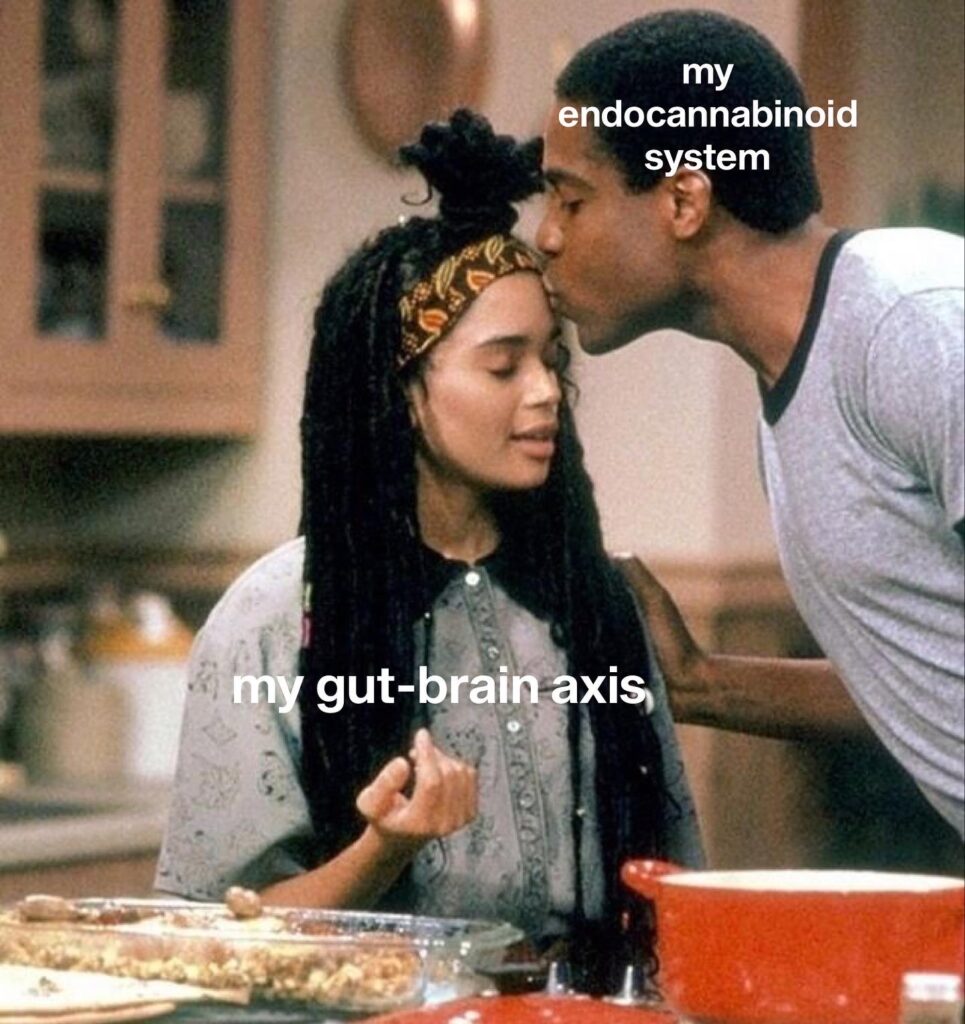
The densely packed endocannabinoid receptors located throughout the gut and the nervous system are activated by cannabinoids. The endocannabinoid anandamide (AEA) helps reduce stress and balance nervous system activity, helping to avoid that sympathetic overdrive. Anandamide is often referred to as “the bliss molecule” due to its ability to improve mood, relieve pain, and promote an overall sense of wellbeing. Our bodies produce anandamide on their own, but the problem is that it degrades quickly and modern lifestyle factors have decreased overall tone and receptivity of system.
…Enter CBD!
CBD does not interact directly with our endocannabinoid receptors like THC does, but rather functions by increasing the amount of anandamide that is able to stay active in our system. Anandamide is broken down by the enzyme FAAH. CBD inhibits (blocks) the action of FAAH, thereby reducing its influence and allowing for higher anandamide levels to be present in the body. CBD has also been shown to naturally boost serotonin and GABA receptivity, giving the vagus nerve a boost when it comes to achieving that ideal autonomic tone.
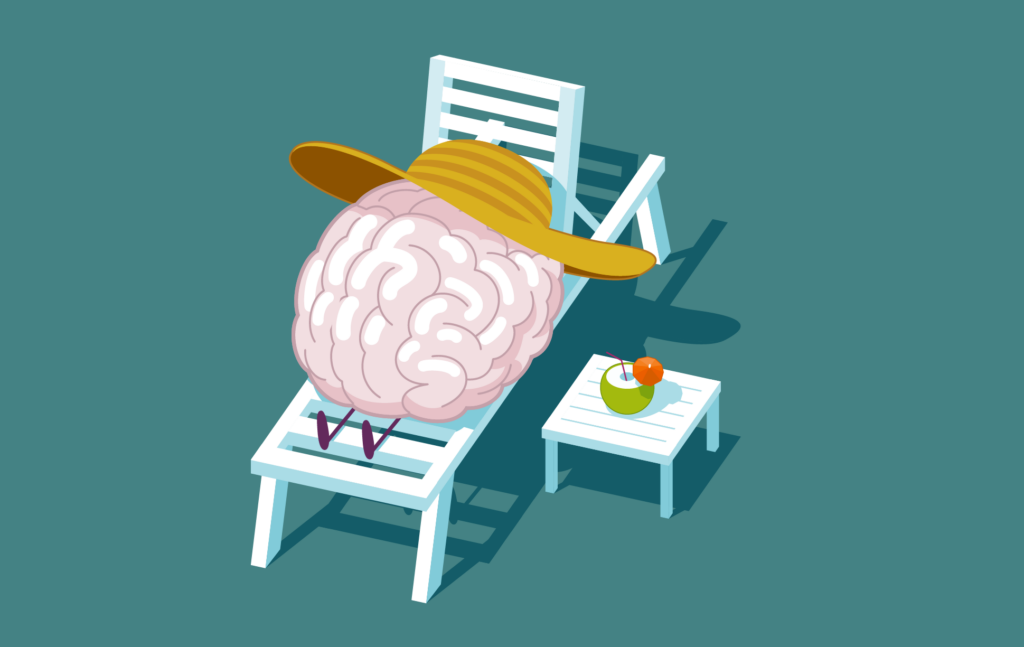
Aside from its ability to regulate the mental and emotional component of our stress response, the endocannabinoid system also addresses the physical component of stress: inflammation. With dense coverage of receptors within the gut (where 70% of our bodies’ immune cells are located) our endocannabinoid system works to not only reduce localized inflammation within the GI tract, but to modulate the inflammatory response being signaled through the gut and to the rest of the body. By maintaining a healthy, balanced environment in the gut, the ECS is ensuring a well-functioning microbiome!
Supplementing with phytocannabinoids like CBD is a great way to improve your endocannabinoid system tone and function. While taking CBD on an as-needed basis to address a specific issue is ok, taking the ‘daily vitamin’ approach to cannabinoid supplementation is the best way to support overall wellness and mind-body balance. Small-moderate daily doses help to keep your ECS in check, but if there are certain days where you need more support you can up the dosage to provide more significant support.
Take it to the next level with TONIC
TONIC Doses – namely The O.G., Chill and Flex, take this support to the next level. By combining CBD with purposeful plant-based ingredients, we are able to provide a more comprehensive and effective wellness solution for both of your brains!
Ashwagandha
- Lowers cortisol levels, helping to get you out of sympathetic overdrive by reducing the signals that are telling your body to stay in fight or flight.
- Found in The O.G. and Chill blends
Lemon balm and passionflower
- Increases GABA levels, helping to slow down your nervous system and strengthen the signal telling your body it’s time to move into rest and digest.
- Found in Chill


 The Steady Supply
The Steady Supply

 Personalized Vibes
Personalized Vibes
